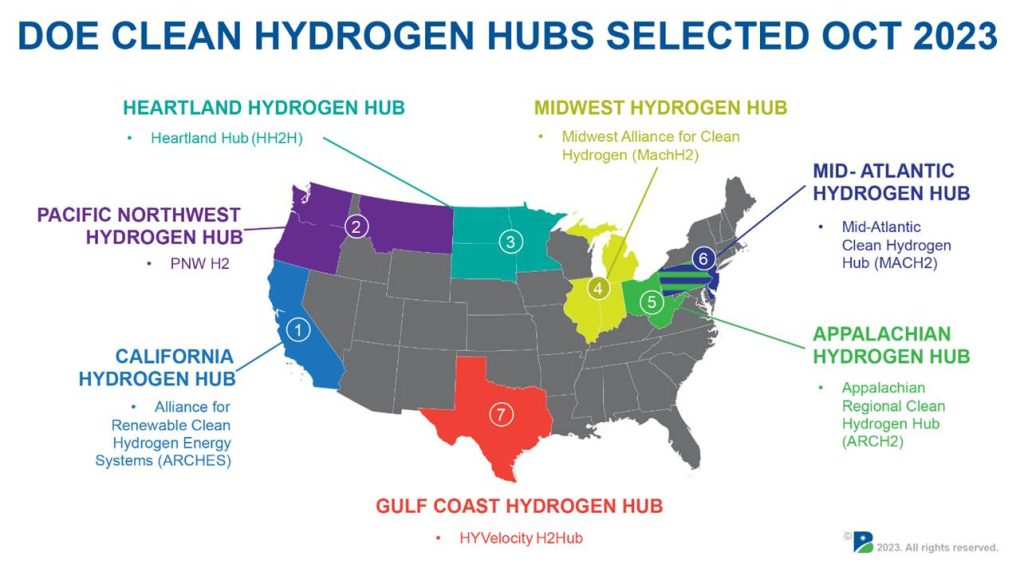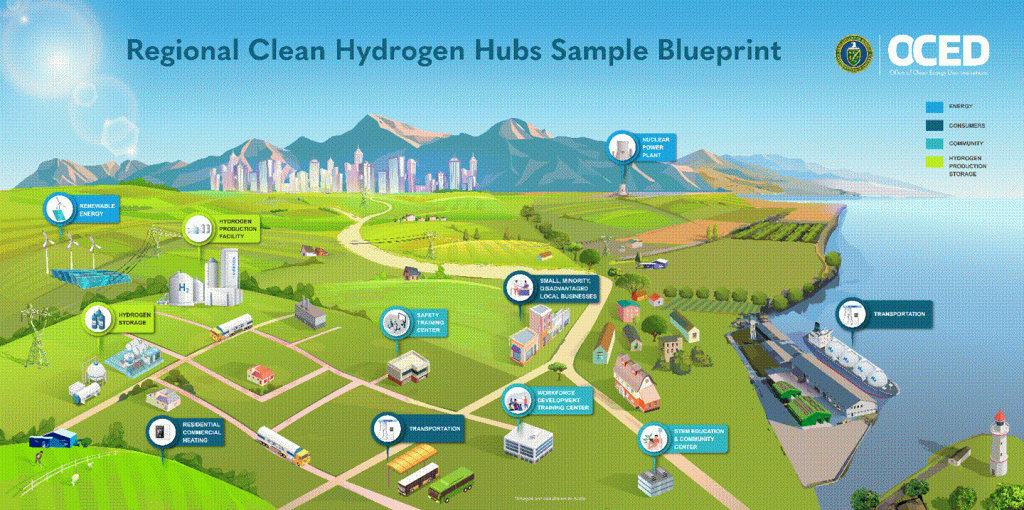DOE HAS IDENTIFIED THE REGIONAL CLEAN HYDROGEN HUBS – WHAT ARE THE NEXT STEPS?
On October 13, 2023 the Department of Energy (DOE) announced the seven regional clean hydrogen (H2) hubs that are to be funded as part of the Bipartisan Infrastructure Law (BIL). These hubs “…will kickstart a national network of clean hydrogen producers, consumers, and connective infrastructure while supporting the production, storage, delivery, and end-use of clean hydrogen.” The H2 hubs are expected to collectively produce three million metric tons of hydrogen annually, reaching nearly a third of the 2030 U.S. production target and lowering emissions from hard-to-decarbonize industrial sectors that represent 30 percent of total U.S. carbon emissions.”(1) Once implemented, these Regional H2 hubs are intended to “…reduce 25 million metric tons of carbon dioxide (CO2) emissions from end-uses each year”—an amount roughly equivalent to combined annual emissions of 5.5 million gasoline-powered cars—and create and retain tens of thousands of good-paying jobs across the country while supporting healthier communities.” (1) Here is an overview of the regional clean H2 hubs based on the information announced by DOE on October 13, 2023: (2)

Background
Before I outline the “Next Steps” and implementation target dates associated with the formal awards and implementation of the DOE regional clean H2 hubs, I want to provide some fundamental background information for readers who may have a limited understanding of “What is a Hydrogen Hub” and “What are the Colors of Hydrogen.”
Hydrogen Hubs

The above DOE figure (2) depicts the principal elements of a typical regional clean H2 hub. However, there are some other elements that may also be included in such a H2 hub. These other elements can include: various pipelines (e.g., H2, CO2, natural gas, ammonia, etc.), large industrial users (e.g., chemicals, steelmaking, industrial heating, gas turbines, electric power generation, backup power, data centers, etc.), hydrogen refueling stations, and sustainable aviation fuels that may be associated with a hydrogen hub.
Hydrogen Colors
There is no universally accepted standard that defines the various colors associated with H2 sources; and, therefore many organizations and authors have referred to an entire spectrum of colors associated with H2. I have found that
Mitsubishi Heavy Industries Group on their MHI Global site provides a simplistic graphic (3) of the colors currently being used in various industry reports, articles, webinars and presentations associated with H2 related topics.

In a future Becht blog “The Evolution of H2 Colors,”- I will provide additional information about the various H2 colors.
“NEXT STEPS” – DOE’s Process and Key Milestones
Most individuals, companies and other entities who aren’t directly involved in the DOE regional clean H2 hub awards may not understand that the DOE currently envisions that the “next steps” in this process are expected to take place over approximately a span of 13 to 14 years. For example, here is an overview of the DOE’s perspective of the “key milestones” involved (5) (9):
| Winter 2023-2024 – Award Negotiations | Phase 1: 2024-2026 – Detailed Planning (12-18 Months) |
| Phase 2: 2025-2029 – Development, Permitting, & Financing (2-3 Years) | Phase 3: 2028-2033 – Install, Integrate, Construct (2-4 Years) |
| Phase 4: 2030-2037 – Ramp Up & Operate (2-4 Years) | |
DOE Strategies to Achieve the Clean Hydrogen Vision (4) (8)
To achieve DOE’s clean hydrogen visions, three key strategies have been established:
- Strategy 1: Target strategic, high-impact uses of clean hydrogen. Federal agencies focus on clean hydrogen to address difficult-to-decarbonize segments of the economy.
- Strategy 2: Reduce the cost of clean hydrogen. Prioritize cost reductions across the value chain.
- Strategy 3: Focus on regional networks. Regional networks will enable large-scale clean hydrogen production close to hydrogen users, enabling the development and sharing of a critical mass of infrastructure.
Regional Clean Hydrogen Hubs
■ Locate large-scale clean hydrogen production near end users
■ Jump-start infrastructure development
Economic Benefits
■ Create well-paid jobs and tax revenue for regional economies
■ Establish a network of hydrogen producers and consumers
The October DOE announcement is a major step forward in implementing strategy 3. However, there is still much effort and many other “steps” prior to fulfilling strategy 3.
DOE Selection Process (5)
The DOE regional clean H2 hubs selection process has involved and will continue to require the integration of multiple criteria and inputs from various governmental agencies. An example of activities and deliverables likely expected to be completed in each phase is shown in the following figure:

DOE Selection Criteria
The BIL H2 hub statutory provisions (9) require that to the maximum extent practicable DOE select proposals that cover the following characteristics:
- Feedstock Diversity: at least one hub shall demonstrate the production of clean hydrogen from fossil fuels, one H2 hub from renewable energy, and one H2 hub from nuclear energy.
- End-Use Diversity: at least one hub shall demonstrate the end-use of clean hydrogen in the electric power generation sector, one in the industrial sector, one in the residential and commercial heating sector, and one in the transportation sector.
- Geographic Diversity: each hub will be located in a different region of the United States and leverage energy resources abundant to that region, including at least two hubs in regions with abundant natural gas resources.
- Employment: DOE shall give priority to regional clean hubs that are likely to create opportunities for skilled training and long-term employment to the greatest number of residents in the region.
In addition, the selection criteria will include evaluation of proposed project characteristics that include cost, schedule, and scope; technology; business; market; financial; management; community support and other factors contained in the NOI. (5)
The key areas DOE evaluated when selecting H2 hubs included: (2)
- Technical Merit and Impact, including but not limited to the ability of the proposed hub to deploy infrastructure and produce at least 50-100 metric tons of clean hydrogen per day and reduce greenhouse gas emissions.
- Financial and Market Viability, including growth potential and market competitiveness of the proposed hub.
- Workplan, including the speed at which the hub could begin operations and overall project management details.
- Management Team and Project Partners, including the team’s ability to execute the plan with a high level of success.
- Community Benefits Plan, including an assessment of community and labor engagement, quality job creation and workforce development, diversity equity inclusion and accessibility, and the Justice40 Initiative.
DOE Interagency Cooperation (6) (7)
On August 18, 2023, DOE announced the formation of Hydrogen Interagency Task Force (HIT) across 11 agencies to further advance a whole-of-government approach to clean hydrogen; and the identification of examples of interagency cooperation that will be involved. The following table summarizes examples of the agencies involved and their focus areas:
- DOT, DOE – pipelines, buses, marine, fueling corridors
- DOD, DOE, DHS across services – H2 rescue truck, vehicles, infrastructure, UAVs, UUVs, soldier power, microgrids, and more
- DOE, USPS – FC lift trucks and hydrogen infrastructure
- NASA, DOE, NSF – cryogenics/LH2, fuel cells, electrolyzers, storage, DOE consortia (NSF)
- DOC (NIST), DOE – metering, diagnostics, supply chain, blends, standards
- EPA, DOE, et al – proposed rulings (EPA), emissions analysis, ports
- USDA – REAP and rural community programs
In addition, the Treasury Department has a critical role, particularly in developing and implementing various tax incentives in the Inflation Reduction Act that will be important in the ramp up of the clean hydrogen economy. (7) As of the time that this blog was created, these tax incentives related to clean hydrogen have not yet been finalized.
Summary
It was with great anticipation that many individuals and companies associated with energy transition and organizations/locales potentially impacted by the hydrogen hub concept awaited the DOE’s regional hub notifications in October 2023. (2) This blog highlights the DOE process for the seven hubs to achieve the hub goals that include:
- Clean hydrogen produced and used at scale in replicable demonstrations and with sustainable business models for market lift off
- Emissions and pollution reduction
- New sustainable jobs, including good-paying union jobs
- Clear benefits for disadvantaged communities
- Exemplary models for skills training, diversity, equity, and inclusion
- Domestic manufacturing
- Sustained economic growth and scaled-up clean hydrogen use
- Additional and sustained private sector investment
As the DOE regional clean hydrogen hub process evolves and when important announcements are made and/or milestones achieved, Becht will provide updated blogs with the pertinent information.
References: “Seven Regional Clean Hydrogen Hubs Will Create Thousands of High-Quality Jobs, Strengthen the Nation’s Energy Security, and Combat the Climate Crisis”, October 13,2023, https://oced.energy@public.govdelivery.com
- “Regional Clean Hydrogen Hubs Selections for Award Negotiations,” Office of Clean Energy Demonstrations, October 13/2023, https://www.energy.gov/oced/regional-clean-hydrogen-hubs-selections-award-negotiations
- “The colors of hydrogen: Expanding ways of decarbonization,” Mitsubishi Heavy Industries Group on their MHI Global site, July 28, 2022, https://spectra.mhi.com/the-colors-of-hydrogen-expanding-ways-of-decarbonization
- “U.S. National Clean Hydrogen Strategy and Roadmap at a Glance,” https://www.hydrogen.energy.gov/docs/hydrogenprogramlibraries/pdfs/clean-hydrogen-strategy-roadmap-at-a-glance.pdf
- “DE-FOA-0002768: Notice of Intent to Issue Funding Opportunity Announcement No. DE-FOA-0002779 – Bipartisan Infrastructure Law: Additional Clean Hydrogen Programs (Section 40314): Regional Clean Hydrogen Hubs,” https://oced-exchange.energy.gov/Default.aspx#FoaId4e674498-618c-4f1a-9013-1a1ce56e5bd3
- “Hydrogen Stakeholder Webinar National Clean Hydrogen Strategy and Roadmap and Interagency Coordination
August 18, 2023,” https://www.hydrogen.energy.gov/docs/hydrogenprogramlibraries/pdfs/webinar-national-hydrogen-strategy-interagency-collaboration.pdf?Status=Master
- “U.S. National Clean Hydrogen Strategy and Roadmap Interagency Collaboration,” https://www.hydrogen.energy.gov/docs/hydrogenprogramlibraries/pdfs/national-hydrogen-strategy-interagency-collaboration.pdf
- “US National Clean Hydrogen Strategy Roadmap,” June 2023. https://www.hydrogen.energy.gov/docs/hydrogenprogramlibraries/pdfs/us-national-clean-hydrogen-strategy-roadmap.pdf
- Infrastructure Investment and Jobs Act, Public Law 117-58 (November 15, 2021), Subtitle B – Hydrogen Research and Development, Section 40314 – Additional clean hydrogen programs. https://www.congress.gov/bill/117th-congress/house-bill/3684

